April Meeting, 1960
A STATED Meeting of the Society was held at its House, No. 87 Mount Vernon Street, Boston, on Thursday, 28 April 1960, at half after eight o’clock in the evening, the President, Mr. Richard Mott Gummere, in the chair.
The records of the Stated Meeting in February were read and approved.
Messrs. Robert Churchill Vose, Jr., and Richard Harding Randall, Jr., were elected Resident Members of the Society.
The chair appointed the following committees in anticipation of the Annual Meeting:
To nominate candidates for the several offices,—Messrs. Elliott Perkins and Fred Norris Robinson.
To examine the Treasurer’s accounts,—Messrs. William Bradford Osgood and Arthur Stanwood Pier.
To arrange for the Annual Dinner,—Messrs. Walter Muir Whitehill and David Britton Little.
Mr. Dean A. Fales, Jr., read a paper entitled:
Joseph Barrell’s Pleasant Hill
I.
“IN the improvement of the land, I hope to find employment as long as I live,” wrote Joseph Barrell in 1794.306 The improvements of his land, its buildings and its people are the subject of this paper, the main purpose of which is to show the relationship between a successful Massachusetts merchant of the late eighteenth century and the craftsmen and artisans about him that made his house in Charlestown, “Pleasant Hill,” the most outstanding private residence built in America during the last decade of the century. Though the house no longer stands and the ground itself has been changed, it is still possible to trace the growth of this amazing building through old records, drawings, and photographs. All these serve as indications of the greatness not only of Pleasant Hill, but of Joseph Barrell himself.
Barrell was born in Boston in 1739, the sixth of eleven sons of John Barrell, Jr., a merchant and shipbuilder. As did most of his brothers, Joseph became a merchant as well as participating on occasion in public life. In 1764 he married Ann Pierce. In the next year their pastel portraits were done by John Singleton Copley, that of Barrell being now at the Worcester Art Museum.
In 1769, among those who appeared in the list of three hundred and fifty-five Sons of Liberty who dined at the Liberty Tree on 14 August, were Samuel and John Adams, Joseph Barrell, James Otis, Jr., and Paul Revere. The same year, on 8 May, in a long advertisement of household wares and food in the Boston Gazette, Barrell advertised brown sugars, “Double and Treble refined,” as well as loaf sugar and coffee. On 11 July 1763, he had advertised “Bristol glass, Boxes of Glass Ware, and Hogsheads of Earthenware, neatly sorted, Wine and Beer Glasses and Decanters curiously engraved with the Mason’s Arms.”
In 1771, his first wife having died, he married Hannah Fitch, whose pastel by Copley attests to her grace. This portrait is in the Museum of Fine Arts, Boston, and was done probably the year they were married. She, like his first wife, unfortunately died still young, during the Revolution.
In the unsettled 1770’s Barrell moved to Waltham, using the harbor of Newburyport for his mercantile operations. On 12 April 1776, he wrote about Boston to his brother William, a Philadelphia merchant,
The shops are not yet open in that town, & though the Redcoat Rascals have deserted, yet a melancholy appearance is alone to be seen in that once happy place. Mr. Green in whose hands I left my affairs, is amongst the fugitives, that carried with him, all my carpets, looking glasses, curtains, beds & bedding & almost every necessary in a household way, that I am not in a capacity to go into Housekeeping, & know not when I shall return to Boston.307
He did return, however, and continued to perform service for his native Boston. In 1776 he was chairman of a committee to examine the town treasury, a member of a committee to prepare instructions for the Massachusetts representatives in the General Assembly, and a juror on the Maritime Court. In 1778 he was chosen as a Representative to the Massachusetts Assembly, was on the school committee, and ran for State senator. In 1784, he was treasurer of a committee which was to incorporate Boston into a city, and a few years later ran unsuccessfully for Governor of Massachusetts.
These few examples will serve to show his interest in public affairs. Many of his letters are fascinating commentaries of events of the time. He returned to Boston after the Revolution, living in a large house on Summer Street. His business boomed, and with relatives in Portsmouth, New York, Philadelphia, London, and France, the Barrell brothers became practically a cartel!
In 1781 Barrell took into his counting house for five years a young family friend, Charles Bulfinch, a graduate of Boston Latin School. This was the start of a long friendship culminating finally in Bulfinch designing “Pleasant Hill” after his European tour in the eighties.
While Bulfinch was working for Barrell, journals of Captain Cook’s voyages to the northwest reached Boston. Tempted by the fur of the sea otter, Barrell was instrumental in fitting out a voyage to this area. The ship Columbia and the sloop Washington, owned by Barrell, Samuel Brown, Charles Bulfinch, John Derby, Crowell Hatch, and John Pintard, left Boston on 30 September 1787, bound to the northwest coast, China, and then Boston. The venture was successful.308 Furs were taken on board in the northwest, where a large river was named for the first vessel, the furs were then taken to China (a stop at the Hawaiian Islands for “refreshment and provisions” made en route), and in China they were traded for a cargo of tea to come back to Boston. Barrell ordered Captain Kendrick to get “Bohea and Hyson tea; blue and white china plates and dishes and tea and coffee cups and saucers, or any other article which you think will answer better in this country.”309 Boston papers hailed the voyage of the first two American ships that went completely around the world as a great triumph. Medals of the expedition were made of silver and copper.310 A silver medal was sent by Barrell to Jefferson. On 2 May 1789, the goldsmith Paul Revere recorded in his ledger the making of six silver medals and repairing the edges of ten copper medals, for Joseph Barrell.311 A silver medal at the Massachusetts Historical Society is one that Barrell gave to the Society in 1791.
In 1792 the owners of the ships received thanks from the Corporation of Harvard College for a present to the museum of “a number of rare curiosities, procured by those vessells from Nootka Sound, and the Sandwich Islands in their late voyage, being the first ever made by Americans to the North West Coast.”
Until 1793, Barrell lived on Summer Street, which at that time was the most beautiful street in Boston. When Reverend William Bentley visited there in 1791, he had this to say:
Was politely received at dinner by Mr. Barrell, & Family, who shewed me his large and elegant arrangements for amusement, & philosophic experiments. His birds played in a globe surrounded with a globe of water in which the fish play. . . . He has a variety of paintings, engravings, & representations in clay from China. He was an adventurer in the first voyage to the back parts of America, & has several great curiosities. His apparatus for experimental Philosophy is good, especially for electricity. He has a good library. The house is elegant in all its furniture. His Garden is beyond any example I have seen. A young grove is growing in the back ground, in the middle of which is a pond, decorated with four ships at anchor, & a marble figure in the centre. The Chinese manner is mixed with the European in the Summer house which fronts the House, below the Flower Garden. Below is the Hot House. In the apartment above are his flowers admitted more freely to the air, & above a Summer House with every convenience. The squares are decorated with Marble figures as large as life. No expense is spared to render the whole amusing, instructive & friendly.312
In the early 1790’s Barrell acquired over two hundred acres overlooking the Charles River at Cobble Hill in Charlestown. It was on this hill that General Knox had built extensive fortifications during the Revolution. This hill, now part of Somerville, was between Charlestown and Boston on the mainland.313 The house was to be Bulfinch’s first private dwelling. Construction started early in 1792; and on 19 September 1792 a traveler, in his Extracts of a Gentleman Visiting Boston, reported this:
On our return struck off from the road (to Cobble Hill), and took a view of the beautiful and commodious edifice which Mr. Joseph Barrell of this town is erecting for his country residence upon an eminence near the Charles River. As it will be the largest, too I think it will be infinitely the most elegant dwelling house ever yet built in New England. It commands the most beautiful views imaginable.
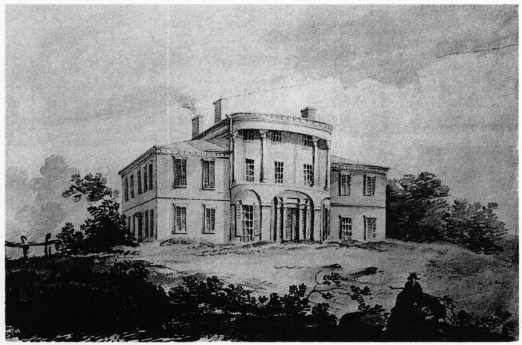
V. East elevation of Pleasant Hill as originally designed. Copy of a sketch now lost.
Courtesy of the Society for the Preservation of New England Antiquities.
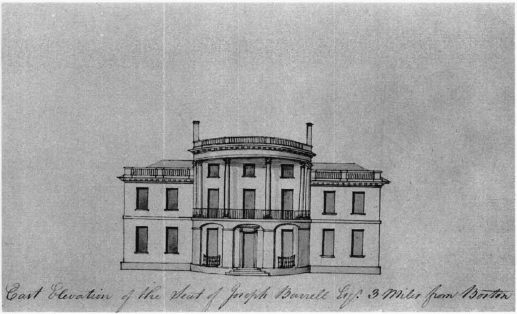
VI. East elevation of Pleasant Hill as originally designed.
Drawing by Charles Bulfinch in the Boston Athenæum.
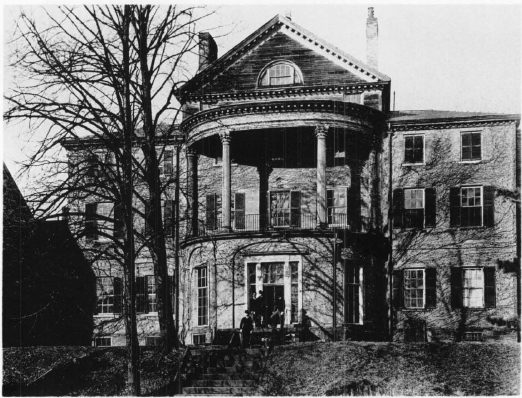
VII. East elevation of Pleasant Hill as altered.
Photograph in the Society for the Preservation of New England Antiquities.
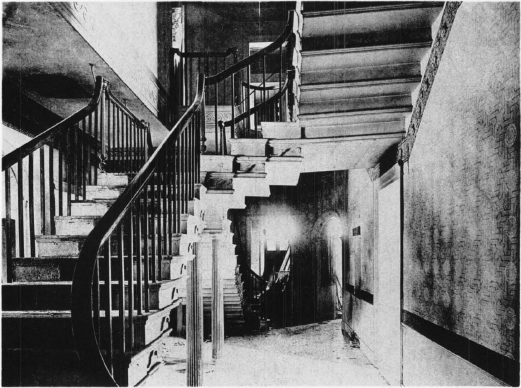
VIII. Staircase in Pleasant Hill, 1792–1896.
Photograph in the Society for the Preservation of New England Antiquities.
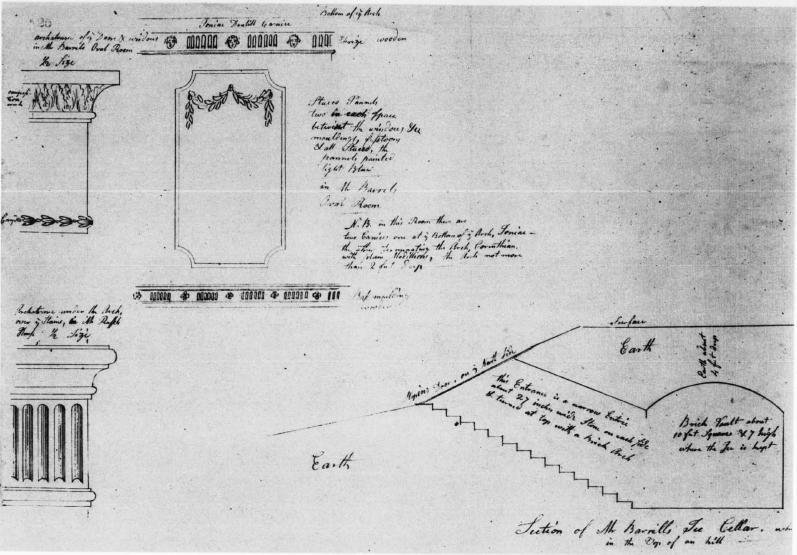
IX. Details of Pleasant Hill sketched by Samuel McIntire.
Drawing in the Essex Institute.
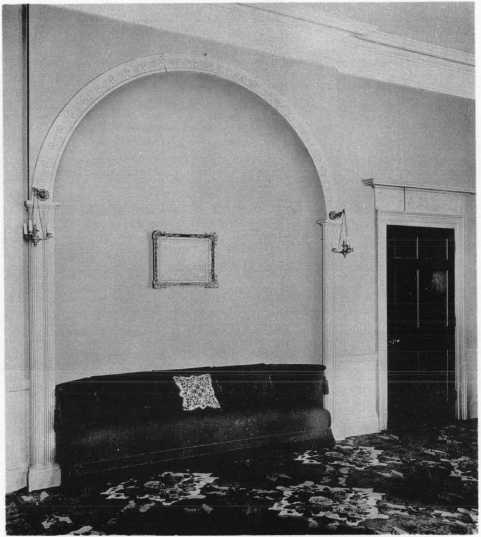
X. Interior of Pleasant Hill.
Photograph in the Metropolitan Museum of Art.
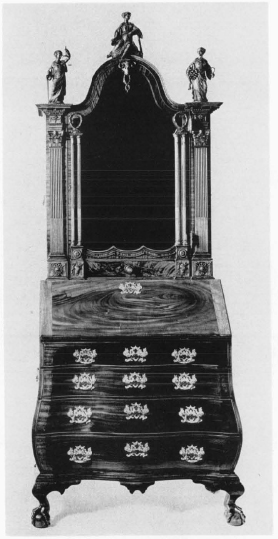
XI. Mahogany desk-and-bookcase once owned by Joseph Barrell.
Courtesy of the Henry Francis du pont
Bentley recorded on the same date, “Barrell’s house advanced to the second story, upon Letchmore’s Point and Coble Hill.”314
It was in this setting that Barrell was to create his ideal country seat. The grounds would be adorned with the finest trees, lawns, terraces, gardens, fish ponds, dovecotes, poultry yard, stables, a large barn and a boat-house.315 The house itself has long been ascribed to Bulfinch by reason of several mentions of his name in Barrell’s letters. However, the rather recent discovery of three of Bulfinch’s own drawings of the house confirms the matter. One of these at the Boston Athenaeum shows the east elevation of the house. This side overlooked his gardens and the Charles River, affording a fine prospect of Boston. The main feature of the house was a large oval drawing room on the main floor, one story high, on the roof of which were two sixteen-foot Corinthian columns, with pilasters against the house, supporting the upper roof which covered the balcony. Bulfinch had seen prototypes for this swell-front type of structure on his trip abroad.
The building was 74 feet by 42 feet. The western front, a carriage entrance, had a porch supported by four Ionic columns, on squares of Scotch granite. The steps, the caps and sills, and the belt course, were of the same stone.
The walls were of brick and the timber of hewn pine, brought from the Kennebec where Barrell had extensive holdings, measuring 12 by 12, and sometimes 16 by 16 inches. The floors were deadened by brick laid between the floor joists, with an under floor laid over them. Brick fire stops or rodent stops were laid behind all the baseboards. The inner partitions not of brick were of two-inch pine plank set very closely together with split hemlock laths, forming a thin, yet very sturdy, partition. From this brief description, it is evident the best and strongest materials were used.
Moving inside the house, the plan of the first floor shows four generous rooms at the corners, the center section given over to the oval room and large vestibule and hallway leading to it. The stairway was an unusual one. It was a flying staircase, ascending at each end, thirty-two feet in length. It came together at a landing in the center, supported by four fluted posts. It then went up three steps to another landing, and diverged to the right and left to landings connecting with the second floor.316
II.
Through his three hundred and fifty-page letter book, a recent gift of Benjamin Joy to the Massachusetts Historical Society, Joseph Barrell is able to tell us much about his house. The letter book covers the years 1792 to 1797 and is restricted mostly to personal—not business—letters that are as complete and valuable a commentary of the trials of the new house owner as any that are written today.
While still living at Summer Street in the winter of 1792 and 1793, he ordered many articles for Pleasant Hill. In December 1792 Barrell had ordered material for finishing some curtains. He wrote to his brother in London, ordering “6 lbs. of silk exactly the colour of the Pattern, as I want it to make fringe for some Damask curtains.”317 It had not arrived five months later, and once again Barrell asked for it, “properly twisted for the fringe.”318 With the first order, he added that his daughter “wishes a compleat set of silk shades for working embroidery.”
On 12 January 1793 he wrote to his brother Nathaniel in New York:
I rec’d your favour by Mr. Bulfinch to observe you had procured the iron hearths. . . . I observe the price of the cover for the table. I should be glad of one but think they are too high. I understand there are candlesticks with them, which I do not want.319
On 13 February he ordered “4 masts of 20 inches and 20 feet long for pillars at my house,” adding, “The longer they have been seasoned, the better.”320 The next month he wrote Nathaniel in New York again, wondering where the iron hearths and live oysters he had ordered were, and also wanted “2 white marble chimney pieces of the whitest marble you can get.”321
In March he wrote to Major Webb of Weathersfield “my house is in forwardness and before the first of May barring accidents, I shall be there.”322 Perhaps the planning had taken its toll, because in the same month he asked his brother Colburn in London to send a watch with a plain dial and large hands “for I find old eyes cannot see as well as young.”323
In the spring, he moved to Pleasant Hill, selling the Summer Street house to Charles Vaughn, the brother-in-law of Bulfinch.324 In a long letter to Nathaniel, it was obvious that not everything was going according to schedule:
I shall depend on the iron hearths, for which, with the marble chimney pieces, I am now waiting. The hearth of marble I think to do without, as Connecticut stone is best for use. Mr. Pomeroy tells me he has given directions for the frames of his looking glasses to be made after the English fashion, & as we have seen some from France lately that are very neat, I wish you would give orders to have my glasses framed in the manner of Mr. Pomeroys & the guilding done in such a way that it will not come off in wetting. The small glasses being for chimney pieces must have only square frames, the others for the piers may be ornamented as fashionable.325
Once more, he wondered where the oysters were. These, by the way, were not for immediate consumption. Barrell had prepared a bed for them in the river, and when they finally arrived, he naturalized them in the Charles River—a feat which certainly would be impossible today! He also introduced several new species of fish to the vicinity as well as domesticating trout in a fountain near his summer house; so it should be stated that his interests extended beyond his land. The oysters had not yet arrived in May, and he expressed his disappointment to Nathaniel once again, also ordering another hearth and an “iron back suitable for the chimney.”326
On 28 May 1793 he wrote to a London agent, Thomas Dickson, ordering carpeting and wallpaper:
I want for a carpet for my hall a painted canvas without seams, 20 by 22, but with the neatest small figure & border, and 25 feet by 8-½ feet each to answer the same figure without any border, as 1 wish to cut it up to have it go under my stairs. I wish the ground a strong bright grass green; also 14 rolls of very handsome paper for a hall—the figures neat & not too large, the ground a handsome stone color. The height of the wall above the dado is 8ʹ 4″, without allowing anything for the border, which may be some guide in chusing a paper that will not cut to waste, And 6 rolls of bright Mazerine blue plain—with borders for both.—The chimney pieces are very handsome, but as I think them too high prized, I shall for the present omit them. The medallions are pretty & I shall keep them. I request you will omit the painted carpets, as I find I can supply myself sooner here.327
In the following year, Barrell wrote to Benjamin Joy:
I’ve just determined to have a carpet for my Summer Room instead of the canvas now on it. I shall therefore be glad if you send for a Brussels carpet of the following dimensions 22 ft. 6 in. x 19ʹ 1″—the colour of the damask enclosed—covered with handsome bunches of flowers.328
In a long series of letters to Shaler and Hall, the firm that provided the Scotch granite for steps and terraces, Barrell constantly had to get after them to make their shipments in time. In June of 1793, he wrote them:
I am exceedingly disappointed in not receiving the stone steps I so long ago desired, more especially those with the string pieces as my laying out my garden is stopped thereby. I hope my disappointment is not owing to your finding the stones for the theatre in Boston, as it was entirely to my recommendation that they were sent for.329
Barrell was on a committee for building this theater, which Bulfinch also designed; and after pointing this out to Shaler and Hall, he was pleased to see that all future orders were handled with great promptness by these Scots. In one letter to them, he told them not to be afraid to tell him if they could not supply him. He merely wanted a definite answer, he said, “‘For the life of suspense is the life of a spider!’”330
Although the transportation situation improved, the problems were not all solved. In the next year he wrote them, “Have waited to consult with Mr. Bulfinch as to some steps I yet want. Those I received last from you either from his mistake or yours are not long enough.”331
On 31 May 1793, Bentley gave this report on the house:
In the morning I stopped at Mr Barrell on Cable hill, so called when a fort was erected there. The plan of the Building is to me new, & not entirely executed. The Saloon is oval fronting the Town. The Cellars are in the best order. The flights of stairs in a vast entry opening towards the country & meet upon the first floor. There is an oval opening above which preserves the communication above, with a neat balustrade & the stairs are back. Every thing discovered expence, but taste, & elegance. The prospect is the best I ever beheld.332
In 1793 and 1794 he also ordered a register stove for his library room—“the border round and japanned,”333 more Corinthian capitals, six gross of cider bottles—which were not to be had in Boston,334 and several Brussels carpets, one an oval one “covered with sprigs.”335 As do many people today, he must have felt that his presence in the partially finished house would help in its more rapid completion. On 1 January 1795 he wrote “My house is entirely finished except my best room. The carpenters’ work will be completed in a few days when I shall wait for plaster of Paris to finish the stucco.”336
The oval room was approximately 32 by 24 feet. In 1795, after the stucco work had been completed, Elias Hasket Derby of Salem received permission to send his own designer, Samuel McIntire, to Pleasant Hill to take notes and make sketches, for Derby wanted the very latest and best ideas to go into the planning of a new house he wanted to build. It is a happy and fitting coincidence that Barrell, Bulfinch, Derby and McIntire should come together in this way, since both Pleasant Hill and the Derby Mansion were perhaps the two most important houses built in Massachusetts in the last decade of the eighteenth century. McIntire’s drawings at Essex Institute give us great insight into the original appearance of the room.337 He drew a door and window capping, while beside it is a sketch of one of the wall panels, with the wooden ceiling molding and base molding. Two of these panels were set between the windows. They were painted a light blue. McIntire also noted that the arched or coved ceiling, which started at the “Ionic dentilled cornice” at the top of this sketch, extended up for two feet, terminating in a Corinthian cornice with plain modillions.
For fitting out the oval room Barrell wrote to his brother Colburn in London in February 1795:
I want 2 Register Stoves to be made exactly as they are for fireplaces in my oval room and are covered by looking glass windows, which by opening, show the fireplace. I mention this that you may know there must be no polished steel about them as they will be much opposed to rust. I would therefore have the border about them of Tutenag or East India white copper, which if you think too dear may be of brass or Princess mettle, but I should prefer the copper.338
The early use of mirrored doors in this letter is noteworthy. Even earlier, in 1793, he had written to his brother Nathaniel in New York, “I beg you will send me by the first opportunity 30 squares of looking glasses 18 x 12″ without frames. I want them to form two windows.”339
In March, he sent to John Atkinson of New York a board as a mold for “two marble hearths of white marble of the best kind. I want them for the 2 fire places in my Oval Room.”340 In November he wrote to John Hoskins:
Therefore desire you will procure for my Oval Room a pair of elegant oval glasses framed in the neatest manner and gilt in such a way that the gilding will not wash off. The space they are to occupy is 4ʹ 3″ by 3ʹ 10″. . . . Pray attend to the packing, for in France they are clumsy enough at that work, and be sure the mirrors are without any flaw or defect of any kind.341
He also asked Hoskins to try to find two pictures for panels in the room, about twenty-one inches square, to match the two paintings “that are in my room, which you remember are views with elegant waterfalls.” The next month he wrote Hoskins again about a chandelier:
I want an elegant lustre for my oval room. If the one you mention is so very elegant, why will it not do? At any rate I wish you to get me one that is light, airy, & elegant, to hold not exceeding 12 lights, and if they should be fixed with argent lamps, I should prefer them to candles, but in that case, they must be absolutely secured from dropping oil.342
He also mentioned he would like four more pictures to flank the mirrors, if Hoskins could find suitable ones.
One interesting feature of the oval room was Barrell’s feeling that the windows must have imported plate glass. He wrote his brother Nathaniel in New York, “Do you hear nothing more respecting the plate glass for my oval room? If it does not come soon, I must have recourse to the glass of this country.”343
There are other mentions of equipment for this room in the letter book, all of which, together with the few poor later photographs which have survived, afford the interested person an exact description of what was the most important room in a Federal dwelling of the time, combining lightness and elegance in the most tasteful manner.
In 1795 Barrell married Electra Brigham of Stockbridge, who was to die a few years later.344 He then married Sarah Webb, the sister of Major Webb of Weathersfield, Connecticut. She survived him. The house was a busy one in the nineties, not only with the activities of Barrell and the children, but with constant visits of many friends, not to mention his own brothers and their families, many of which are still genealogists’ nightmares.
In 1797, however, one visitor was interested in more than the house. Joseph Dennie, Jr., who has optimistically been called the American Addison, was more than delighted with young Hannah. He wrote in August:
For at five o’clock I found myself, by Barrell’s civility, at his chateau and by his daughter’s side . . . I am not much in the habit of tacking on the epithets, angelic and divine, by way of fringe to a petticoat, but am willing to allow that Miss B. is a very perfect mortal, and as pretty a piece of flesh as any in all Messina.4
Had Dennie’s eye been taken by the inanimate furnishings of Pleasant Hill, we might have a clearer picture of the objects used there. Some are known, however, and they, with the letter book and Barrell’s inventory, give us some knowledge of the interior accessories.
Although he had lost most of his household furnishings during the Revolution, a few pieces had been saved. Among them was a large French tapestry showing a bucolic scene, now owned by a descendant. In 1789, when Washington visited Boston, Barrell lent this for a formal assembly accorded the important guest. He was also one of a committee of three to escort Washington from Worcester to Boston for the occasion using his own equipment. This tapestry was used also at Pleasant Hill in the summer dining room, and in 1796 he wrote John Hoskins asking him if he could find another “elegant piece of tapestry 13 feet long and 8ʹ 3″ high.”345
In his dining room, he had some Höchst German procelain figures—or “images.” His London agent procured them from a sale at an English country house and Barrell was very pleased to have been able to acquire these objects which had been originally owned by a member of the British nobility.346
In April of 1795 he wrote Hoskins:
If you meet with a handsome cover for a (dining) table of looking glass, and a pyramid of handsome cut glass for the middle of the table . . . I wish you would buy them. Also 4 handsome damask table cloths 22ʹ by 8ʹ.347
He also asked Hoskins to find for him “a set of elegant coolers for the table, 2 for glasses and 4 for decanters—or half the number of each—and second hand.”348 The desire for elegance was constantly tempered by the hand that held the purse strings.
In 1795 from his agent John Atkinson in New York he ordered:
Also 18 of the handsomest Windsor chairs fit for Dining and my Hall. I would have them with arms, rather less in the seat than larger than common, as they will thereby accomodate more at table. I would have them painted of light blue grey colour, the same as my summer dining room. Let them be strong and neat.349
This, with the exception of looking glasses, is one of the few references to furniture in the letter book. Since the letters are to people living away from Boston, and since they mention little furniture, we can assume that much of it was produced locally. One important piece owned by him is a large mahogany desk-and-bookcase now at Winterthur. Upon a typically fine Massachusetts kettle or bombé base is a mirrored upper section with very rich carving. Carved swags, leafage, rams’ heads and paterae abound, and the top of the case is surmounted by three carved female figures representing Justice and Prosperity flanking Hope at the top. While the carver and cabinetmaker are not known, the work is of the highest quality. This desk was given to his daughter Hannah after she married Benjamin Joy and descended in the Joy family. While the base seems of an earlier period than the top, the construction of the piece indicates they were made for each other, and family history reveals the piece was like this in the 1840’s. It is a superb American desk-and-bookcase, yet one that is tantalizing in its original owner’s silence about it.
The use of allegorical figures like those on the upper section of the bookcase, can be seen in the bookplate of Joseph Barrell. At the top, as on the bookcase, is the figure of Hope. Industry and Indolence are also featured in the design, with their results graphically shown. The mottoes at the bottom are “Not always so” and “Indure but Hope.” Impressions of this bookplate, which may well have been the source for the bookplate of Thomas Russell engraved by Joseph Callender of Boston, are known in both black and green ink, the latter probably for either Barrell’s rarer volumes, or for a specialized collection.
Another Barrell-Joy family piece is a convex girandole mirror. The gilt frame is surmounted with a large shell, with leafage flanking it, and at the bottom two sconces, each holding two candles, are attached. Its dimensions are very close to the two Barrell ordered from France for the Oval Room. Several of these were ordered for the house, and since some were returned due to breakage, it is difficult to say where this one originally hung.
Besides the Copley portraits already mentioned, there are other family likenesses. Barrell had painted a miniature of himself by Copley and had it put in a gold bracelet which he gave his daughter Hannah. Also, Barrell had the young Boston artist Henry Sargent paint for him a portrait of the Reverend John Clarke, the minister of the First Church in Boston. This portrait is now at the Massachusetts Historical Society.350 There are also other miniatures and silhouettes of the Barrell family in private collections.
A great deal of silver is listed in the inventory, including a tea set, several salvers, and many spoons, as well as plated sconces, candlesticks, decanter stands and many other items. All of this is rather amazing, since it is known he gave his best silver to his daughter and sons before he died. A pair of cans, made long before the time of Pleasant Hill, were made by Knight Leverett of Boston for Dr. Thomas Bulfinch. They passed from him to his son Charles, who gave them to Hannah before she married Benjamin Joy. They are now owned by Mark Bortman of Boston and on loan to the Museum of Fine Arts.
Probably a great part of the silver came from abroad. However, we have seen Barrell had the Columbia expedition medals made by Paul Revere in 1789. Later entries in the Revere ledgers charged Barrell in 1793 for “mending sundries” and on 28 July 1796, for “mending cream pitchers” and for “a silver letter B for the back of chairs.” This most likely refers to a chaise.351
There are also in existence some English glasses—barrel-shaped, of course—and decanters still owned by a descendant. In 1797 he ordered glasses from England. He did not want a case, however, since he said he already had “a very handsome Shagreen one.”352 Also there are a few other small pieces owned by descendants.
In the letter book, Barrell frequently ordered watches and jewelry from London. In one letter to his brother, Barrell ordered a watch for Hannah:
My daughter who is a very good girl, wishes a gold key in the form of a very handsome Urn, both sides of christel & the lock of her Father’s hair herewith plaited neatly & fixed between.353
This custom, then, was not always a posthumous panegyric!
Barrell was most interested in various phases of science, and in the letter book he was constantly ordering various pieces of equipment, usually from London, from maps, barometers, telescopes, microscopes and thermometers to a shower bath, magnets, a pedometer, rain gauges and elaborate electrical instruments.354 On one occasion he ordered a large supply of fireworks.
III.
This interest in science was most evident in his landscape work. When Timothy Dwight visited Pleasant Hill in 1799, he wrote:
It is now a beautiful plantation, and considering the short period since it was begun, highly improved. The house furnishes one of the best prospects of this charming country.355
It should have been beautiful, for Barrell planted thousands of trees and shrubs, as well as creating many gardens, terraces, and fountains. In the 1790’s, as until recently, the New Englander’s main plantings consisted of fruit trees. Barrell ordered countless pears, cherries, apples, and peaches from England. One order alone consisted of twenty each of twenty-one varieties of pear trees.356 Another ordered from a nursery in Bordeaux 40 pear trees, 20 nectarines, 20 apricots, 20 peaches, 20 cherries, 20 plums and 20 grapes.357 He also ordered dwarf and espaliered fruit trees, especially peaches.358 He was constantly experimenting with new types, improving fruiting habits of his trees through better pollination, and striving to develop hardier varieties of selected more tender species.
In 1793 he asked his brother Nathaniel in New York to send him one of Prince’s lists.359 William Prince and Son, in Flushing, had established the first successful commercial American nursery, issuing tree and seed catalogues before the Revolution. With this firm Barrell placed several large orders.
As Pleasant Hill was being built, Barrell and Bulfinch were two of twenty-eight men who petitioned to have the Massachusetts Society for Promoting Agriculture incorporated in March of 1792. Two years later he wrote to one of his chief suppliers, William Pringle of Lyndenham in Kent, ordering certain trees which “are spoken highly of by The Compleat Farmer, by a Society of Gentlemen.”360 This book, The Compleat Farmer; or a general Dictionary of Husbandry in all its Branches, especially the fourth London edition, was the foremost guide of late eighteenth- and early nineteenth-century gardeners and farmers and was owned throughout Federal America.361
Since the shipments from abroad were often damaged in transit or arrived at an improper planting time, the rate of mortality of the stock was frequently alarmingly high. Barrell had a Dutchman as his head gardener until he returned to Holland in 1793,362 after which he was replaced with an Englishman recommended by Pringle. This replacement was not an easy process, however. Barrell wrote to Pringle in January of 1794:
The person you procured for me as Gardner, Mr. James Rule, I believe is a clever man, but as I found on his arrival he had an utter aversion to be employed with any other Gardner, & as the person I have is a very good man, although I had full employ for 2 for the present season, yet to make him happy I consented he should engage with Mr. Jeffrey who stands in my employ.363
Many shrubs and flowers were imported for small gardens. Great attention was also given to farming operations. In addition, many ornamental and shade trees—such as the American elm and the then ubiquitous poplar—were planted on the long avenues laid out on the grounds, as were walnuts, mulberries, and other nut trees.364 A greenhouse “nearly two hundred feet in length” provided ample room for both experimentation and winter blooms for the house.365 It was here that Barrell grew successfully some of the first double white camellias in New England.366 Two stoves for the hothouse were ordered from England.367 Oleanders, olives, oranges, and lemons were also grown in it.
When McIntire was at Pleasant Hill, he must have received instructions to pay particular attention to Barrell’s icehouse, and he made a measured drawing of it.368 Before refrigeration came in, the problem of keeping ice in the summer was almost as great as getting rid of it in the winter. Barrell had dug down inside a hill, atop which was a terrace, and had a chamber 10 feet square and 7 feet high for his ice storage. With over twelve hundred bottles of liquor, wines, and cider listed in his inventory, this subterranean chamber assumes even more importance.
Garden figures had become very important after the Revolution and in his inventory are listed “2 urn pedestals, figures of cupids, Venus, a gardener and his wife, 4 wooden horses and a stone horse.”
IV.
At sometime in the late nineties, Barrell became gravely ill.369 His pace did not slacken entirely, however. He continued at work in Boston, traveling by either his splendid horses on land, or across the river from his boathouse on his barge with liveried boatmen.370 He let others carry on the main portion of his business, while he invested heavily in lands in the Pacific northwest, Ohio, the Carolinas, and Georgia. Finally, in 1804 he died, having already given many of his treasures to his daughter and five sons. In an eight-page will and codicil, he carefully spelled out the disposition of his estate—so carefully, in fact, that twelve years later his sons were still fighting with Benjamin Joy, the executor, about his not properly living up to the will. In a pamphlet battle they accused Joy of mismanagement, while he maintained his position most intelligently. Though the battle raged, it did not dim the luster of Pleasant Hill. It had cost Barrell $48,000, a large amount for that time, yet an amount which, I hope, we will agree was wisely spent.371
In May of 1805, Bentley wrote in his diary:
The valuable Library of Joseph Barrell at Corn Hill, is to be sold tomorrow. This excentric man was a man of uncommon taste & for many years while he resided in Summer street, Boston, was a man of the best taste & could exhibit the best specimens. No man in New England was before him in his hospitality, unbanity [sic], & polite accomplishments.372
In 1816 Pleasant Hill was sold by Joy to the Massachusetts General Hospital to become the McLean Asylum. Bulfinch, who was still living, added another story with a pediment to the house, continued the ends up to three stories, and made two large buildings, each 40 by 76 feet, flanking the main building.373
An engraving in Richard Frothingham’s History of Charlestown shows how the buildings looked in the early 1840’s. There may be seen the pier in the foreground, as well as some of the trees that Barrell had planted. A charming water color, owned by Nina Fletcher Little, entitled “Insane Hospital Charlestown,” shows the same scene with more vigor, though with less precision.374 Throughout the nineteenth century, the buildings remained the most important in Charlestown. One author wrote of the asylum:
Here the poor patients whose wits are out may ramble in the pleasant paths and “babble o’ green fields.” Here we may see a Lear, there an Ophelia,—old and young, rich and poor, but with an equality of wretchedness that levels all worldly condition.375
Photographs taken in the eighteen nineties, show the west, or carriage, entrance, the bottom two floors of which were the original house, and the river side.
In 1896, the Boston and Maine Railroad, in the midst of a frenzy of expansion, bought the estate, after the McLean Asylum had moved to Waverley. The house was demolished, the hill was leveled, the river was filled in, and today what was once Pleasant Hill is now part of the main Boston classification freight yard of the railroad.
Pleasant Hill now exists only on paper and in its later state in the childhood memories of a few. There is no doubting it was a magnificent house, and all the credit for it must go to its owner. Being a wealthy merchant with many distant connections, Barrell did not hesitate in ordering anything he wanted from anywhere he wished. He looked beyond his own area, as must have many others in his state, frequently letting his own taste be guided by impressive things he had seen in his own travels. While Revere might mend a cream pitcher, at the same time Barrell would send one of his daughter’s gold bracelets and a locker to London for repair, as well as some satin to be dyed.376 Since his world of business was an international one, the world of furnishing and building his house was likewise. Its design was done by a local architect, and the elements of the house came from everywhere, looking glasses from France, and carpets—and even composition ornaments—from England.377 He was an extremely astute man, paying constant attention to world affairs, idealizing his own country above all others, and loving his family deeply with the warmest affection. His ethics are nowhere more clearly shown than in a fourteen-page letter to his eldest son, giving advice on how to get along in the world. While this paper has not explored this side of his character, nevertheless I hope we have seen that he was an intelligent and a worthwhile patron who gave the fullest meaning possible to his employment “in the improvement of the land.”
